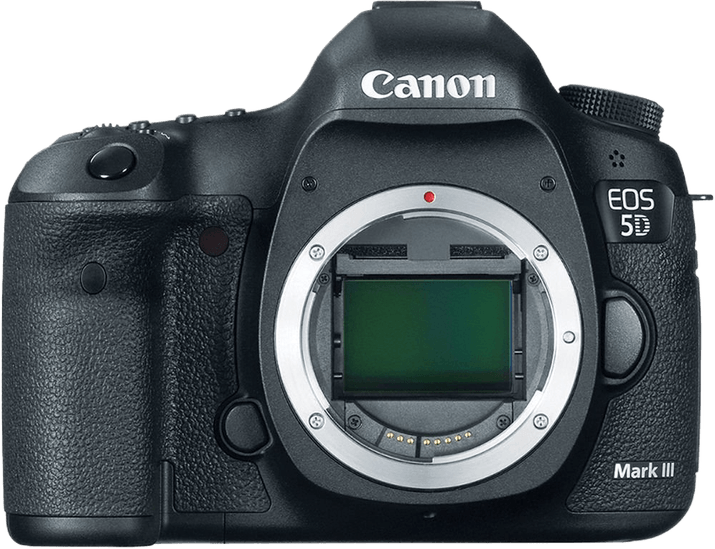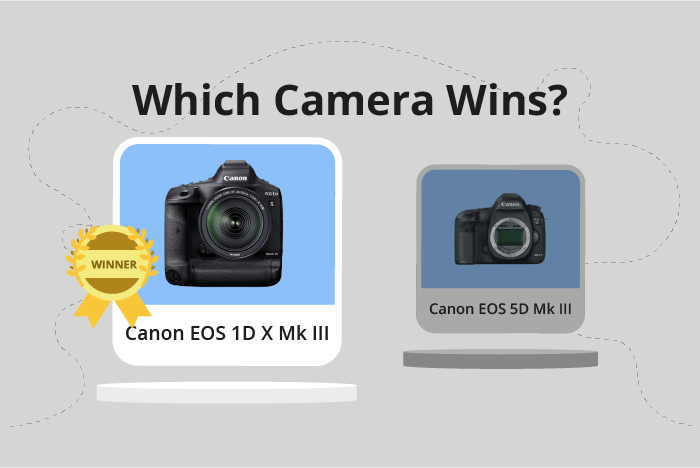Canon EOS 1D X Mark III vs EOS 5D Mark III Comparison
Canon EOS 1D X Mark III

Canon EOS 5D Mark III

The Canon EOS 1D X Mark III outperforms the Canon EOS 5D Mark III with a score of 75/100 compared to 65/100. Both cameras are DSLRs and share similar specifications. However, the 1D X Mark III, released in 2020, is a more advanced camera than the 5D Mark III, which was released in 2012.
The 1D X Mark III has a smaller and lighter body, measuring 158 x 168 x 83mm and weighing 738g, making it more convenient for photographers. On the other hand, the 5D Mark III has a more affordable launch price of $3499 compared to the 1D X Mark III’s $6500.
In terms of performance, the Canon EOS 1D X Mark III clearly surpasses the 5D Mark III, justifying its higher score. However, budget-conscious photographers may still find value in the Canon EOS 5D Mark III due to its lower price.
Canon EOS 1D X Mark III vs EOS 5D Mark III Overview and Optics
The Canon EOS 1D X Mark III takes the lead in optics, scoring 74 out of 100, while the Canon EOS 5D Mark III trails behind with a score of 67. Both cameras share several common specifications, including the CMOS sensor type, full-frame sensor size, Canon EF lens mount, and the absence of image stabilization.
The 1D X Mark III outperforms the 5D Mark III in several aspects. It boasts a faster shooting speed of 20 frames per second, compared to the 5D Mark III’s 6 frames per second. This advantage allows the 1D X Mark III to capture fast-moving subjects with ease. Additionally, the 1D X Mark III’s Digic X processor is more advanced than the 5D Mark III’s Digic 5+ processor, enabling better image processing and overall performance. The 1D X Mark III also has a higher DXOMARK score for its sensor, with a score of 91 compared to the 5D Mark III’s 81, indicating superior image quality.
On the other hand, the 5D Mark III has a slightly higher megapixel count of 22.3, compared to the 1D X Mark III’s 20.1 megapixels. This higher resolution may provide marginally better image detail for certain applications, such as landscape photography or large print sizes.
Taking these factors into account, the Canon EOS 1D X Mark III stands as the superior camera in terms of optics, due to its faster shooting speed, advanced processor, and higher sensor score. However, the Canon EOS 5D Mark III may still be a viable option for those who prioritize a higher megapixel count for specific applications.
Canon EOS 1D X Mark III vs EOS 5D Mark III Video Performance
The Canon EOS 1D X Mark III outperforms the Canon EOS 5D Mark III in video capabilities, with a video score of 91/100 compared to the 5D Mark III’s score of 56/100. Both cameras share some common video specifications, such as having a max video frame rate of 60fps, but there are significant differences that make the 1D X Mark III superior.
The 1D X Mark III boasts a max video resolution of 4K (4096 x 2160), while the 5D Mark III has a max video resolution of Full HD (1920 x 1080). This means the 1D X Mark III can capture videos with higher resolution and more detail than the 5D Mark III. Furthermore, the 1D X Mark III has a higher max video frame rate of 120fps, enabling users to capture slow-motion footage with greater fluidity and detail. Additionally, the 1D X Mark III has built-in time-lapse functionality, which the 5D Mark III lacks.
On the other hand, the 5D Mark III still offers satisfactory video performance for casual users or those who do not require 4K resolution. Its Full HD video resolution and 60fps frame rate are sufficient for most non-professional applications. However, it falls short in comparison to the 1D X Mark III’s advanced video capabilities.
Considering the significant differences in video specifications, the Canon EOS 1D X Mark III is the clear winner in terms of video capabilities. It offers superior video resolution, higher frame rates, and built-in time-lapse functionality, making it a better choice for those who prioritize video performance. The Canon EOS 5D Mark III remains a viable option for casual users or those with less demanding video requirements, but it cannot compete with the 1D X Mark III’s advanced features.
Canon EOS 1D X Mark III vs EOS 5D Mark III Features and Benefits
The Canon EOS 1D X Mark III outperforms the Canon EOS 5D Mark III with a feature score of 74/100 compared to the latter’s 59/100. Both cameras share some specifications: they have the same screen size of 3.2 inches and neither has a flip screen.
The 1D X Mark III excels in several aspects. It has a higher screen resolution of 2,100,000 dots, which is double the 5D Mark III’s 1,040,000 dots. This difference makes the 1D X Mark III’s screen sharper and clearer for better image preview and review. Additionally, the 1D X Mark III is equipped with a touchscreen, making it more user-friendly and efficient to navigate through settings and modes. The 5D Mark III lacks this feature. Furthermore, the 1D X Mark III has GPS and WIFI capabilities, which the 5D Mark III does not. These features allow the 1D X Mark III to track location data and transfer files wirelessly, providing more convenience and functionality.
On the other hand, the 5D Mark III does not have any notable advantages over the 1D X Mark III. Both cameras lack Bluetooth, but this is a minor downside considering the other features they offer.
In comparing these two cameras, the Canon EOS 1D X Mark III is clearly a superior choice due to its higher feature score, touchscreen, higher screen resolution, GPS, and WIFI capabilities. The Canon EOS 5D Mark III falls short in these aspects, making the 1D X Mark III the better option for photographers seeking a more advanced and feature-rich camera.
Canon EOS 1D X Mark III vs EOS 5D Mark III Storage and Battery
The Canon EOS 1D X Mark III outperforms the Canon EOS 5D Mark III in storage and battery with a score of 87/100, compared to the latter’s 76/100. Both cameras have two memory card slots, but the 1D X Mark III uses CFexpress Type B cards, while the 5D Mark III accepts SD/SDHC/SDXC, Compact Flash, and UDMA cards. The 1D X Mark III has a significantly longer battery life, providing 2850 shots with its LP-E19 battery, as opposed to the 5D Mark III’s 950 shots using an LP-E6 battery. Neither camera supports USB charging.
The 1D X Mark III’s superior battery life offers photographers more shooting time without needing to replace or recharge batteries. In addition, its use of CFexpress Type B cards allows for faster read and write speeds, improving the camera’s overall performance.
On the other hand, the 5D Mark III provides more flexibility in memory card options, making it easier for photographers to utilize existing cards or find replacements. However, its shorter battery life may require more frequent battery changes during extended shooting sessions.
Considering these factors, the Canon EOS 1D X Mark III excels in storage and battery life, while the Canon EOS 5D Mark III offers greater memory card compatibility, but falls short in battery performance.
Canon EOS 1D X Mark III vs EOS 5D Mark III – Our Verdict
Are you still undecided about which camera is right for you? Have a look at these popular comparisons that feature the Canon EOS 1D X Mark III or the Canon EOS 5D Mark III:

